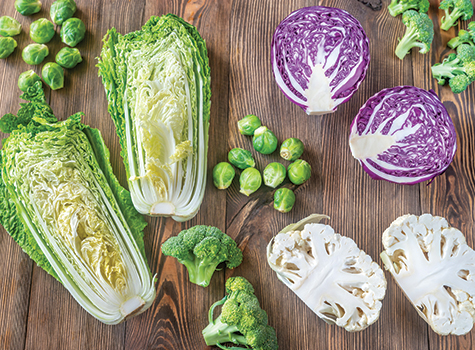
As we start the new year, most of us are bound to start thinking about new year’s resolutions, and what we can do to improve our health.
We know that we all should be eating more vegetables. It is recommended to eat a minimum of three servings of vegetables per day. Ideally, it is recommended to eat 5-9 servings of fruits and vegetables, with the ratio of more vegetables than fruits. Of course, individual needs vary depending on your medical history, but there is no denying that vegetables are very important for our health.
Every group of vegetables has important benefits, and each color can give you a different set of antioxidants and nutrients. There is one group of vegetables that is more potent than all the others!
The cruciferous group of vegetables has been shown to give the most bang for your buck. Let’s learn more about these, and why we should include them in our diet regularly.
Cruciferous vegetables belong to the Brassica family of plants. These include:
Arugula
Bok choy
Broccoli
Brussels sprouts
Cabbage
Cauliflower
Collard greens
Horseradish
Kale
Mustard
Radishes
Rutabaga
Turnips
Watercress
Wasabi
Cruciferous vegetables are rich in nutrients, including several carotenoids (beta-carotene, lutein, zeaxanthin); vitamins C, E, and K, folate, and minerals such as calcium and iron. They are also a good source of fiber.
Cruciferous vegetables contain a group of substances known as glucosinolates, which are sulfur-containing chemicals. These chemicals are responsible for the pungent aroma and bitter flavor of cruciferous vegetables.
When these vegetables are cut, chopped, or chewed, the glucosinolates are broken down to form biologically active compounds, including a potent phytochemical called sulforaphane.
Research has shown that this phytochemical has powerful antioxidant and anti-inflammatory properties. Studies have shown a link between intake of cruciferous vegetables and the risk of cancer, specifically reducing risks of prostate, colorectal , lung, and breast cancer.
In addition, some studies show that eating vegetables high in sulforaphane causes reduction in depression, improved pain management, reduction in obesity and improved conditions related to liver health and cardiovascular disease.
Crucifers can be harder to digest
The very compound that makes these veggies the healthiest is also the one that can create gas. Cooked cruciferous vegetables may be easier to digest than raw.
However, there is a caveat. The glucosinolates in crucifers need the enzyme myrosinase to form sulforaphane and other health-promoting compounds. Cooking the vegetables can destroy the myrosinase, which means the glucosinolates don’t get converted to make sulforaphane. So, while this makes the vegetables easier to digest, it can reduce their nutritional potency.
But the good news is that there is a work around solution. The trick is to chop the vegetables and let them rest for at least 30-40 minutes before cooking them or eating them. This helps the conversion process, and then the cooking doesn’t destroy the enzymes.
So, prep the veggies ahead of time rather than cutting and cooking them right away!
Ways to add cruciferous vegetables to your diet:
Fortunately, we don’t have to look far to be able to able incorporate these vegetables into our diet. A lot of our traditional recipes already use these vegetables. Think of aloo gobi, sarson ka saag, cabbage poriyal or sambharo, mooli koshimbir / paratha / bhurji etc.
â— Broccoli / cauliflower soup
â— Asian style noodles / rice stir fry w/ broccoli & Bok Choy
â— Roasted Brussels sprouts – roast Brussels sprouts with low sodium soy sauce and balsamic vinegar. Thinly sliced or shaved Brussels sprouts can also be added to stir fry
â— Thai style peanut salad with red cabbage and other vegetables
â— Collard greens patra – use collard leaves to make patra instead of the traditional Colocasia leaves
â— Kale salad or added to soup or baked kale chips
â— Horseradish or wasabi sauce
â— Root vegetable roast with turnips and rutabagas
â— Arugula salad or put arugula on a sandwich or homemade pizza
â— Add thinly sliced cabbage to traditional kanda poha or batata poha made with onions/potatoes
â— You can make any traditional sabji or daal with any of these vegetables using desi masala. Other traditional recipes include muthia, handvo, tikkis, koftas or kebabs made with these vegetables
In short, try to incorporate many varieties of cruciferous vegetables in your diet.
Start your new year with color and eat a rainbow.
Wishing you all a healthy and harmonious New Year!
Parul Kharod is a registered dietitian and licensed nutritionist and works as a Clinical Dietitian. She can be reached at parulkharod@gmail.com



